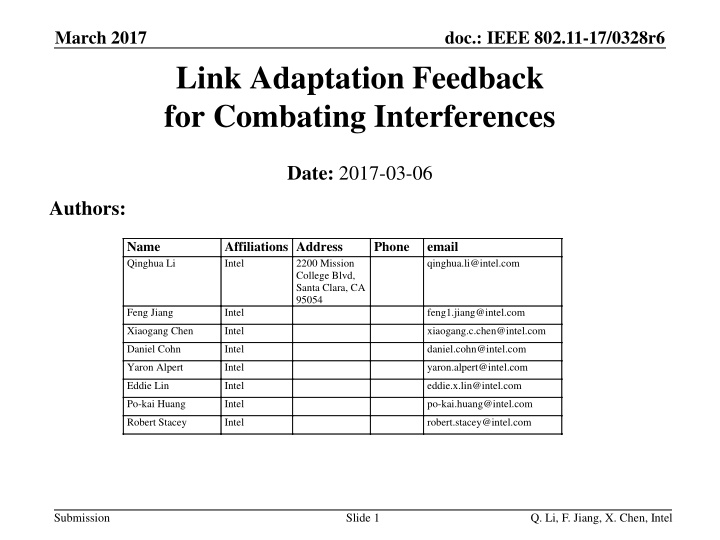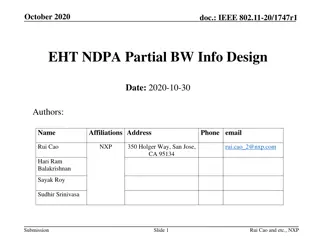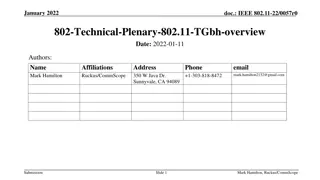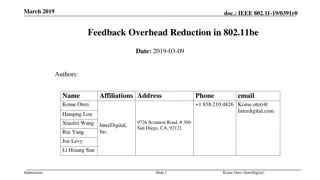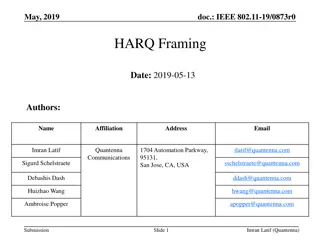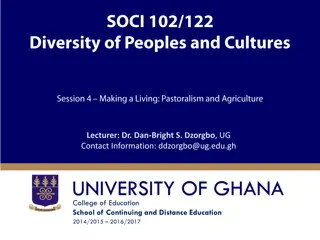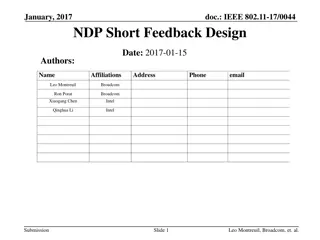Enhancing IEEE 802.11 Network Performance with Adaptive Feedback
This document discusses link adaptation feedback strategies to combat interferences in IEEE 802.11 networks. It addresses issues like throughput drop due to interferences, the presence of narrow-band and on-off interferences, and the ineffectiveness of reducing MCS levels. Solutions include using DCM and short MPDU efficiently for NBI and OOI, with the need for feedback to guide transmitter behavior. The adaptation mechanism considers various MCS levels and recommendations for DCM usage.
Download Presentation

Please find below an Image/Link to download the presentation.
The content on the website is provided AS IS for your information and personal use only. It may not be sold, licensed, or shared on other websites without obtaining consent from the author.If you encounter any issues during the download, it is possible that the publisher has removed the file from their server.
You are allowed to download the files provided on this website for personal or commercial use, subject to the condition that they are used lawfully. All files are the property of their respective owners.
The content on the website is provided AS IS for your information and personal use only. It may not be sold, licensed, or shared on other websites without obtaining consent from the author.
E N D
Presentation Transcript
March 2017 doc.: IEEE 802.11-17/0328r6 Link Adaptation Feedback for Combating Interferences Date: 2017-03-06 Authors: Name Qinghua Li Affiliations Address Intel Phone email qinghua.li@intel.com 2200 Mission College Blvd, Santa Clara, CA 95054 Feng Jiang Intel feng1.jiang@intel.com Xiaogang Chen Intel xiaogang.c.chen@intel.com Daniel Cohn Intel daniel.cohn@intel.com Yaron Alpert Intel yaron.alpert@intel.com Eddie Lin Intel eddie.x.lin@intel.com Po-kai Huang Intel po-kai.huang@intel.com Robert Stacey Intel robert.stacey@intel.com Submission Slide 1 Q. Li, F. Jiang, X. Chen, Intel
March 2017 doc.: IEEE 802.11-17/0328r6 Problem statement (1/3) Interferences cause throughput drop and even link loss Interference Throughput with legacy link adaptation Low average throughput Time Throughput knowing presence of interference High average throughput Time Submission Slide 2 Q. Li, F. Jiang, X. Chen, Intel
March 2017 doc.: IEEE 802.11-17/0328r6 Problem statement (2/3) Unlike noise, interferences usually concentrate in part of frequency or time Narrow band interference (NBI) e.g. clock harmonics and Bluetooth On-off interference (OOI) e.g. microwave oven, Bluetooth, and USB bus Freq Freq Narrow band interference On- off inter feren ce MPDU corrupted by interference Time Time Submission Slide 3 Q. Li, F. Jiang, X. Chen, Intel
March 2017 doc.: IEEE 802.11-17/0328r6 Problem statement (3/3) Reducing MCS doesn t help Narrow band interference still corrupts the same percentage of signal On-off interference causes a vicious cycle: with lower MCS, MPDU duration becomes longer and more vulnerable to interference Freq On- off inter feren ce On- off inter feren ce MPDU corrupted by interference Time Slide 4 Q. Li, F. Jiang, X. Chen, Intel Submission
March 2017 doc.: IEEE 802.11-17/0328r6 Solutions DCM and short MPDU are efficient for NBI and OOI However, Tx doesn t even know the presence of interference at Rx Survived MPDU Freq Freq Narrow band interference On- off interf erenc e Duplicated DCM copies Time Time Submission Slide 5 Q. Li, F. Jiang, X. Chen, Intel
March 2017 doc.: IEEE 802.11-17/0328r6 Adaptation via feedback Link adaption feedback can tell transmitter to use DCM and short MPDU for combating narrow band interference and on-off interference, respectively CID 9619, The HE-MCS defined in 28.5 varies depending on DCM. The HE link adaptation mechanism should also include a recommendation of the DCM. Submission Slide 6 Q. Li, F. Jiang, X. Chen, Intel
March 2017 doc.: IEEE 802.11-17/0328r6 Link adaptation feedback Currently, link adaptation parameters i.e. Nss and MCS are piggybacked in Aggregated Control subfield of HE variant HT control field in MAC header Submission Slide 7 Qinghua Li, Intel
March 2017 doc.: IEEE 802.11-17/0328r6 Available feedback field Control Information subfield of link adaptation still has 9 reserved bits currently Submission Slide 8 Q. Li, F. Jiang, X. Chen, Intel
March 2017 doc.: IEEE 802.11-17/0328r6 Feedback for DIM Use 1 reserved bit for Rx to recommend DCM Combat NBI by sending data over two sets of tones B15 B0 B8 B2 B3 B6 B7 HE-MCS Reserved NSS DCM 1 Bits: 3 4 8 Submission Slide 9 Q. Li, F. Jiang, X. Chen, Intel
March 2017 doc.: IEEE 802.11-17/0328r6 Feedback for short MPDU Use 1 reserved bit for Rx to recommend short MPDU duration (SMD) Combat OOI by shortening MPDU duration e.g. down to 0.2 ms Indicate the presence of OOI such that Tx knows RSSI is not reliable for link adaptation A-MPDU MPDU 2 MPDU 1 MPDU 64 B9 B15 B0 B2 B3 B6 B7 B8 DCM SMD Reserved HE-MCS NSS 1 Bits: 3 4 7 1 Submission Slide 10 Q. Li, F. Jiang, X. Chen, Intel
March 2017 doc.: IEEE 802.11-17/0328r6 Summary Reducing MCS is not efficient to combat interference Tx needs to tell Rx about the presence of interference A-Control field still has 9 bits available for link adaptation Propose to use 1 reserved bits for DCM and 1 reserved bit for short MPDU duration Submission Slide 11 Q. Li, F. Jiang, X. Chen, Intel
March 2017 doc.: IEEE 802.11-17/0328r6 Straw Poll 1 Do you support using one reserved bit in Control Info subfield of HE link adaptation for DCM? For example B0 B2 B3 B6 HE-MCS DCM NSS 1 Bits: 3 4 Y: N: A: Submission Slide 12 Q. Li, F. Jiang, X. Chen, Intel
March 2017 doc.: IEEE 802.11-17/0328r6 Straw Poll 2 Do you support using one reserved bit in Control Info subfield of HE link adaptation for short MPDU duration? Recommend to use short MDPU duration e.g. 0.2 ms For example B0 B2 B3 B6 HE-MCS SMD NSS Bits: 3 4 1 Y: N: A: Submission Slide 13 Q. Li, F. Jiang, X. Chen, Intel
